Chemical and Phytocoenological Characteristics of Two Different Slovak Peatlands
Abstract
:1. Introduction
2. Materials and Methods
2.1. Characteristics of the Studied Sites
2.2. Soil Sampling and Analyses
3. Results and Discussion
3.1. Organic Carbon Contents
3.2. Contents of Nutrients, Soil Reaction, and Risk Elements Contents
3.3. Phytocoenological Characteristics
3.4. Hierarchical Cluster Analysis (HCA)
3.5. Non-Metric Multidimensional Scaling (NMDS) Ordination Based on Bray–Curtis Dissimilarity of the Six Plots in the Peatland Complex
4. Conclusions
Author Contributions
Funding
Institutional Review Board Statement
Informed Consent Statement
Acknowledgments
Conflicts of Interest
References
- Gustafsson, L.; Felton, A.; Felton, A.M.; Brunet, J.; Caruso, A.; Hjältén, J.; Lindbladh, M.; Ranius, T.; Roberge, J.M.; Weslien, J. Natural Versus National Boundaries: The Importance of Considering Biogeographical Patterns in Forest Conservation Policy. Conserv. Lett. 2015, 8, 50–57. [Google Scholar] [CrossRef] [Green Version]
- Barthelmes, A. The global potential and perspectives for paludiculture. In Paludiculture—Productive Use of Wet Peatlands Climate Protection—Biodiversity—Regional Economic Benefits; Wichtmann, W., Schröder, C., Joosten, H., Eds.; Schweizerbart Science Publishers: Stutgart, Germany, 2006; pp. 200–203. [Google Scholar]
- Swindles, G.T.; Morris, P.J.; Baird, A.J.; Blaauw, M.; Plunkett, G. Ecohydrological feedbacks confound peat-based climate reconstructions. Geophys. Res. Lett. 2012, 39. [Google Scholar] [CrossRef] [Green Version]
- Zhou, Y.; Davidson, T.A.; Yao, X.; Zhang, Y.; Jeppesen, E.; de Souza, J.G.; Wu, H.; Shi, K.; Qin, B. How autochthonous dissolved organic matter responds to eutrophication and climate warming: Evidence from a cross-continental data analysis and experiments. Earth Sci. Rev. 2018, 185, 928–937. [Google Scholar] [CrossRef]
- Timmermann, T.; Margóczi, K.; Takács, G.; Vegelin, K. Restoration of peat-forming vegetation by rewetting species-poor fen grasslands. Appl. Veg. Sci. 2009, 9, 241–250. [Google Scholar] [CrossRef]
- Wu, H.Y.; Li, X.X.; Shi, L.B.; Wang, Z.H.; Ma, F.Y. Distribution of nematodes in wetland soils with different distance from the Bohai sea. Plant Soil Environ. 2008, 54, 359–366. [Google Scholar] [CrossRef] [Green Version]
- Keddy, P.A. Wetland Ecology Principles and conservation; Cambridge University Press: Cambridge, UK, 2010. [Google Scholar]
- Viceníková, A. Ecological characteristic and classification of bogs. In Peatlands of Slovakia; Stanová, V., Ed.; DAPHNE: Bratislava, Slovakia, 2000. [Google Scholar]
- Ward, S.E.; Bardgett, R.D.; McNamara, N.P.; Ostle, N.J. Plant functional group identity influences short-term peatland ecosystem carbon flux: Evidence from a plant removal experiment. Funct. Ecol. 2009, 23, 454–462. [Google Scholar] [CrossRef]
- Lindsay, R. Bogs: The Ecology, Classification and Conservation of Ombrotrophic Mires; Scottish Natural Heritage: Edinburgh, UK, 1995. [Google Scholar]
- Yu, Z.C.; Loisel, J.; Brosseau, D.P.; Beilman, D.W.; Hunt, S.J. Global peatland dynamics since the last glacial maximum. Geophys. Res. Lett. 2010, 37. [Google Scholar] [CrossRef]
- Charman, D.J. Peatlands and Environmental Change; John Wiley and Sons: London, UK, 2002. [Google Scholar]
- Vitt, D.H. Functional characteristics and indicators of boreal peatlands. In Boreal Peatland Ecosystem, Ecological Studies; Wieder, R.K., Vitt, D.H., Eds.; Springer: Berlin, Germany, 2006; Volume 188, pp. 9–24. [Google Scholar]
- Abel, S.; Haberl, A.; Joosten, H. A Decision Support System for Degraded Abandoned Peatlands Illustrated by Reference to Peatlands of the Russian Federation; Michael Succow Foundation for Protection of Nature: Greifswald, Germany, 2011. [Google Scholar]
- Michalko, J.; Berta, J.; Magic, J. Geobotanical Map ČSSR; Veda: Bratislava, Slovakia, 1986. [Google Scholar]
- Joosten, H.; Tapio-Biström, M.L.; Tol, S. Peatlands—Guidance for Climate Change Mitigation through Conservation, Rehabilitation and Sustainable Use; FAO and Wetlands International: Rome, Italy, 2012. [Google Scholar]
- Pellerin, S.; Lagneau, L.A.; Lavoie, M.; Larocque, M. Environmental factors explaining the vegetation patterns in a temperate peatland. C. R. Biol. 2009, 332, 720–731. [Google Scholar] [CrossRef] [Green Version]
- Macrae, M.; Devito, K.; Strack, M.; Waddington, J. Effect of water table drawdown on peatland nutrient dynamics: Implications for climate change. Biogeochemistry. 2013, 112, 661–676. [Google Scholar] [CrossRef]
- Banaś, K.; Gos, K.; Szmeja, J. Factors controlling vegetation structure in peatland lakes, two conceptual models of plant zonation. Aquat. Bot. 2012, 96, 42–47. [Google Scholar] [CrossRef]
- Diggelen, R.; Middleton, B.; Bakker, J.; Grootjans, A.; Wassen, M. Fens and floodplains of the temperate zone: Present status, threats, conservation and restoration. Appl. Veg. Sci. 2006, 9, 157–162. [Google Scholar] [CrossRef] [Green Version]
- Mitsch, W.J.; Gosselink, J.G. Wetlands, 2nd ed.; Van Nostrand Reinhold Co.: New York, NY, USA, 1993. [Google Scholar]
- Šefferová Stanová, V.; Hájek, M. Slovakia. In Mires and Peatlands of Europe. Status, Distribution and Conservation; Joosten, H., Tanneberger, F., Moen, A., Eds.; Schweizerbart Science Publisher: Stutgart, Germany, 2017; pp. 625–632. [Google Scholar]
- Gojdičová, E. Protected Peatlands of the Prešov Region. In Peatlands of Slovakia; Stanová, V., Ed.; DAPHNE: Bratislava, Slovakia, 2000; pp. 87–94. [Google Scholar]
- Šeferová Stanová, V.; Dítě, D.; Janák, M. Management model for peat bogs. In Management Models for Maintenance, Protection and Restoration of Wetland Habitats; Šeferová Stanová, V., Ed.; State Nature Protection of the Slovak Republic: Banská Bystrica, Slovakia, 2015; pp. 103–129. [Google Scholar]
- NATURA 2000b. Bogs Belianske Lúky. Available online: http://www.sopsr.sk/natura/?p=4&sec=5&kod=SKUEV0144 (accessed on 10 April 2021).
- NATURA 2000a. Fens Oravská Kotlina. Available online: http://www.sopsr.sk/natura/index.php?p=4&sec=5&kod=SKUEV0057 (accessed on 10 April 2021).
- Šefferová Stanová, V.; Dítě, D.; Janák, M. Fens. In Management Models for Grassland Habitats; Šeferová Stanová, V., Plassman Čierna, M., Eds.; DAPHNE: Bratislava, Slovakia, 2011; pp. 36–37. [Google Scholar]
- Trnka, R. Peatland Biodiversity Protection in Protected Landscape Area Upper Orava. In Peatlands of Slovakia; Stanová, V., Ed.; DAPHNE: Bratislava, Slovakia, 2000; pp. 51–58. [Google Scholar]
- Mazúr, E.; Jakál, J. Atlas of SSR Text Part; Veda: Baratislava, Slovakia, 1982. [Google Scholar]
- Slovak Hydrometeorological Institute. Climate Atlas of Slovakia; SHI: Bratislava, Slovakia, 2015. [Google Scholar]
- Marek, D. Landscape EcologicalPplan of the Cadastral Area Spišská Belá; ARKA-Architect’s office: Košice, Slovakia, 2007. [Google Scholar]
- Balkovič, J.; Bedrna, Z.; Bublinec, E.; Čurlík, J.; Dlapa, P.; Fulajtár, E.; Gömöryová, E.; Gregor, J.; Hanes, J.; Houšková, B.; et al. Morphogenetic Classification System of Soils in Slovakia. Basal Reference Taxonomy; NPPC SSCRI: Bratislava, Slovakia, 2014. [Google Scholar]
- Kobza, J.; Barančíková, G.; Čumová, L.; Dodok, R.; Hrivňaková, K.; Makovníková, J. Methods of Determining Indicators of Agrochemical Soil Properties; SSCRI: Bratislava, Slovakia, 2011. [Google Scholar]
- Marhold, K.; Hindák, F. The List of Higher and Lower Plants of Slovakia; Veda: Bratislava, Slovakia, 1998. [Google Scholar]
- Shannon, C.E. A mathematical theory of communication. Bell Sys. Tech. J. 1948, 27, 379–423. [Google Scholar] [CrossRef] [Green Version]
- Jurko, A. Ecological and Socioeconomic Assessment of Vegetation/Ekologické a Socioekonomické Hodnotenie Vegetácie (in Slovak); Príroda: Bratislava, Slovakia, 1990. [Google Scholar]
- Klingenfuß, C.; Roßkopf, N.; Walter, J.; Heller, C.; Zeitz, J. Soil organic matter to soil organic carbon ratios of peatland soil substrates. Geoderma 2014, 235, 410–417. [Google Scholar] [CrossRef]
- Barančíková, G. Application of Nuclear Magnetic Resonance Spectroscopy in Studies of Organic Matter in Soil. Chem. Listy. 2008, 102, 1100–1106. [Google Scholar]
- Enev, V.; Pospíšilová, L.; Klučáková, M.; Liptaj, T.; Doskočil, L. Spectral characterization of selected humic substances. Soil Water Res. 2014, 9, 9–17. [Google Scholar] [CrossRef] [Green Version]
- Schnitzer, M.; McArthur, D.F.E.; Schulten, H.R.; Kozak, L.M.; Huang, P.M. Longterm cultivation effects on the quantity and quality of organic matter in selected Canadian prairie soils. Geoderma 2006, 130, 141–156. [Google Scholar] [CrossRef]
- Georgakopoulos, A. Aspects of solid state 13C CPMAS NMR spectroscopy in coals in the Balkan Peninsula. J. Serb. Chem. Soc. 2003, 68, 599–605. [Google Scholar] [CrossRef]
- Hammond, T.E.; Cory, D.G.; Ritchey, W.M.; Morita, H. High resolution solid state 13C n.m.r. of Canadian peats. Fuel 1985, 64, 1687–1695. [Google Scholar] [CrossRef]
- Barančíková, G. Monitoring of quantitative and qualitative composition of soil organic matter. In Soil Monitoring of Slovak Republic; Kobza, J., Ed.; SSCRI: Bratislava, Slovakia, 2009; pp. 55–79. [Google Scholar]
- Barančíková, G.; Makovníková, J. The influence of humic acid quality on the sorption and mobility of heavy metals. Plant Soil Environ. 2003, 49, 565–571. [Google Scholar] [CrossRef] [Green Version]
- Davis, R.B.; Anderson, D.S. The eccentric bogs of Maine: A rare wetland type in the United States. Maine AES Bull. 1991, 146, 4–21. [Google Scholar]
- Szajdak, L.W.; Jezierski, A.; Wegner, K.; Meysner, T.; Szczepański, M. Influence of Drainage on Peat Organic Matter: Implications for Development, Stability, and Transformation. Molecules 2020, 25, 2587. [Google Scholar] [CrossRef]
- Bhuiyan, R.; Minkkinen, K.; Helmisaari, H.S.; Ojanen, P.; Penttilä, T.; Laiho, R. Estimating fine-root production by tree species and understorey functional groups in two contrasting peatland forests. Plant Soil. 2017, 412, 299–316. [Google Scholar] [CrossRef] [Green Version]
- León, C.A.; Martínez, G.O.; Gaxiola, A. Environmental Controls of Cryptogam Composition and Diversity in Anthropogenic and Natural Peatland Ecosystems of Chilean Patagonia. Ecosystems. 2018, 21, 203–215. [Google Scholar] [CrossRef]
- Norton, S.A.; Dillon, P.J.; Evans, R.D.; Mierle, G.; Kahl, J.S. The history of atmospheric deposition of Cd, Hg, and Pb in North America: Evidence from lake and peat bog sediments. In Acidic Precipitation. Advances in Environmental Science; Lindberg, S.E., Page, A.L., Norton, S.A., Eds.; Springer: New York, NY, USA, 1990; Volume 3, pp. 73–102. [Google Scholar]
- Martinez-Cortizas, A.; Pontevedra-Pombal, X.; Munoz, J.N.; García-Rodeja, E. Four thousand years of atmospheric Pb, Cd and Zn deposition recorded by the ombrotrophic peat bog of Penido Vello (Northwestern Spain). Water Air Soil Pollut. 1997, 100, 387–403. [Google Scholar] [CrossRef]
- Sadiq, M.; Alam, I. Arsenic chemistry in a groundwater aquifer from the Eastern Province of Saudi Arabia. Water Air Soil Pollut. 1996, 89, 67–76. [Google Scholar] [CrossRef]
- Hoffmann, M.; Mikutta, C.; Kretzschmar, R. Arsenite binding to natural organic matter: Spectroscopic evidence for ligand exchange and ternary complex formation. Environ. Sci. Technol. 2013, 47, 12165–12173. [Google Scholar] [CrossRef]
- Aapala, K.; Rehell, S.; Similä, M. Peatland biodiversity. In Ecological Restoration in Drained Peatlands; Similä, M., Aapala, K., Penttinen, J., Eds.; Metsähallitus Natural Heritage Services: Vaanta, Finland, 2014; pp. 26–33. [Google Scholar]
- NATURA 2000c. Šúr. Available online: http://www.sopsr.sk/natura/index.php?p=4&sec=5&kod=SKUEV0279 (accessed on 10 April 2021).
- Hájek, M.; Horsák, M.; Hájková, P.; Dítě, D. Habitat diversity of central European fens in relation to environmental gradients and an effort to standardise fen terminology in ecological studies. Perspect. Plant Ecol. Evol. Syst. 2006, 8, 97–114. [Google Scholar] [CrossRef]
- Bernátová, D.; Mirga, V. Biogeographically significant components of peat vegetation in the Orava basin and Podbeskydská ravine. In Proceedings OM XXVIII—2011; Orava Museum: Dolný Kubín, Slovakia, 2012. [Google Scholar]
- Raučina, Š.; Janota, D. Peatlands in Slovakia, their use and protection/Rašeliniská na Slovensku, ich využitie a ochrana. Ceskoslov. Ochr. Prírody. 1963, 1, 17–55. (In Slovak) [Google Scholar]
- Krištín, A.; Sliacka, A.; Jarčuška, B. Orthoptera of the peat bogs and wet mountain grasslands in Orava region (NW Slovakia). Fragm. Faunist. 2012, 55, 91–99. [Google Scholar] [CrossRef] [Green Version]
- Wheeler, B.D.; Proctor, M.C.F. Ecological gradients, subdivisions and terminology of north-west European mires. J. Ecol. 2000, 88, 187–203. [Google Scholar] [CrossRef]
- Nakamura, T.; Uemura, S.; Yabe, K. Hydrochemical regime of fen and bog in north Japanese mires as an influence on habitat and above-ground biomass of Carex species. J. Ecol. 2002, 90, 1017–1023. [Google Scholar] [CrossRef]
- Hájková, P.; Hájek, M. Bryophyte and vascular plant responses to base-richness and water level gradients in Western Carpathian Sphagnum-rich mires. Folia Geobot. 2004, 39, 335–351. [Google Scholar] [CrossRef]
- Gagnon, F.; Rochefort, L.; Lavoie, C. Spontaneous revegetation of a peatland in Manitoba after peat extraction: Diversity of plant assemblages and restoration perspectives. Botany 2018, 96, 779–791. [Google Scholar] [CrossRef]
- Purre, A.H.; Truus, L.; Ilomets, M. A decade of vegetation development on two revegetated milled peatlands with different trophic status. Mires Peat. 2021, 27. [Google Scholar] [CrossRef]
- Chen, X.; Bu, Z.; Stevenson, M.A.; Cao, Y.; Zeng, L.; Qin, B. Variations in diatom communities at genus and species levels in peatlands (central China) linked to microhabitats and environmental factors. Sci. Total Environ. 2016, 568, 137–146. [Google Scholar] [CrossRef] [PubMed]
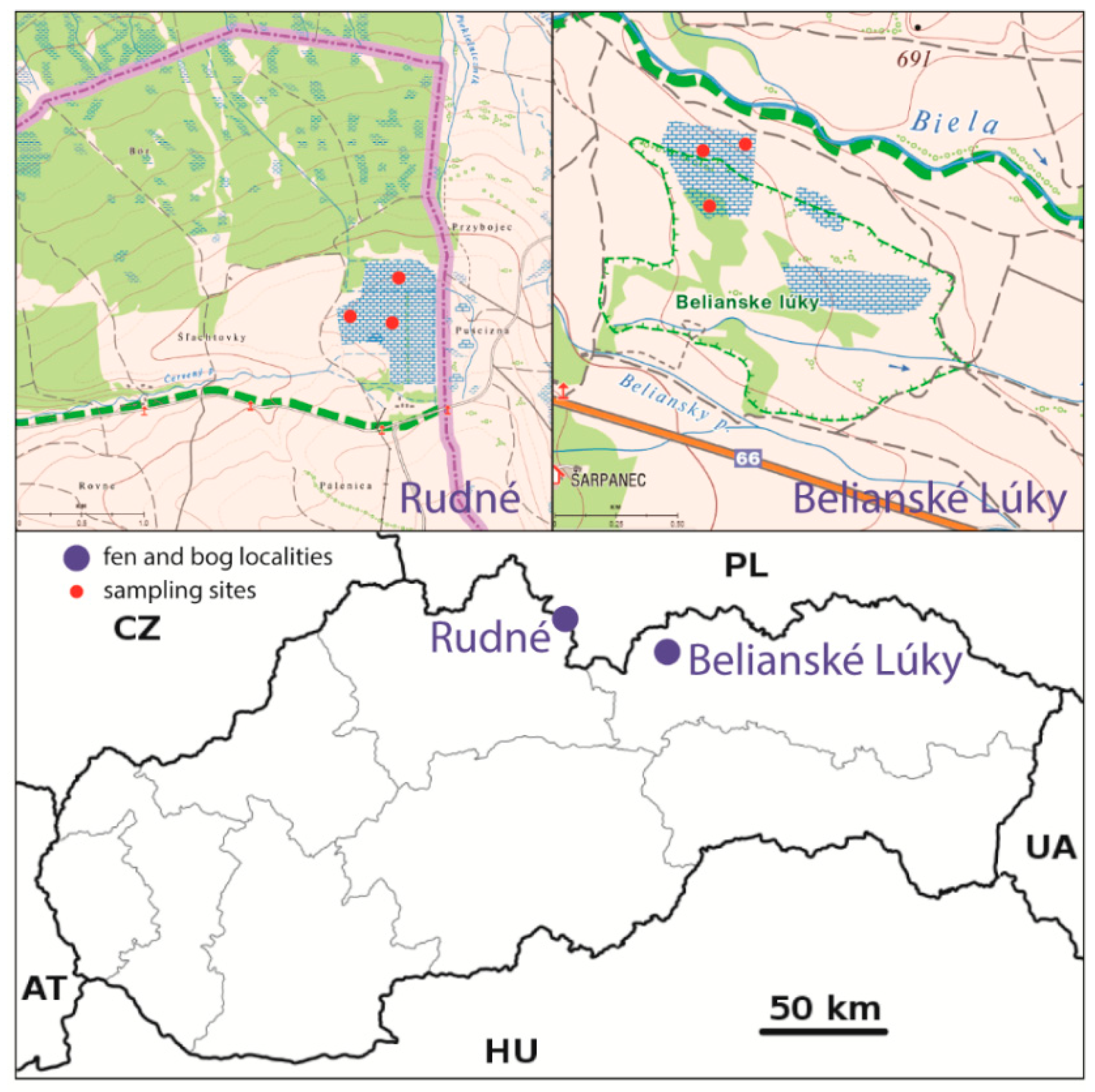

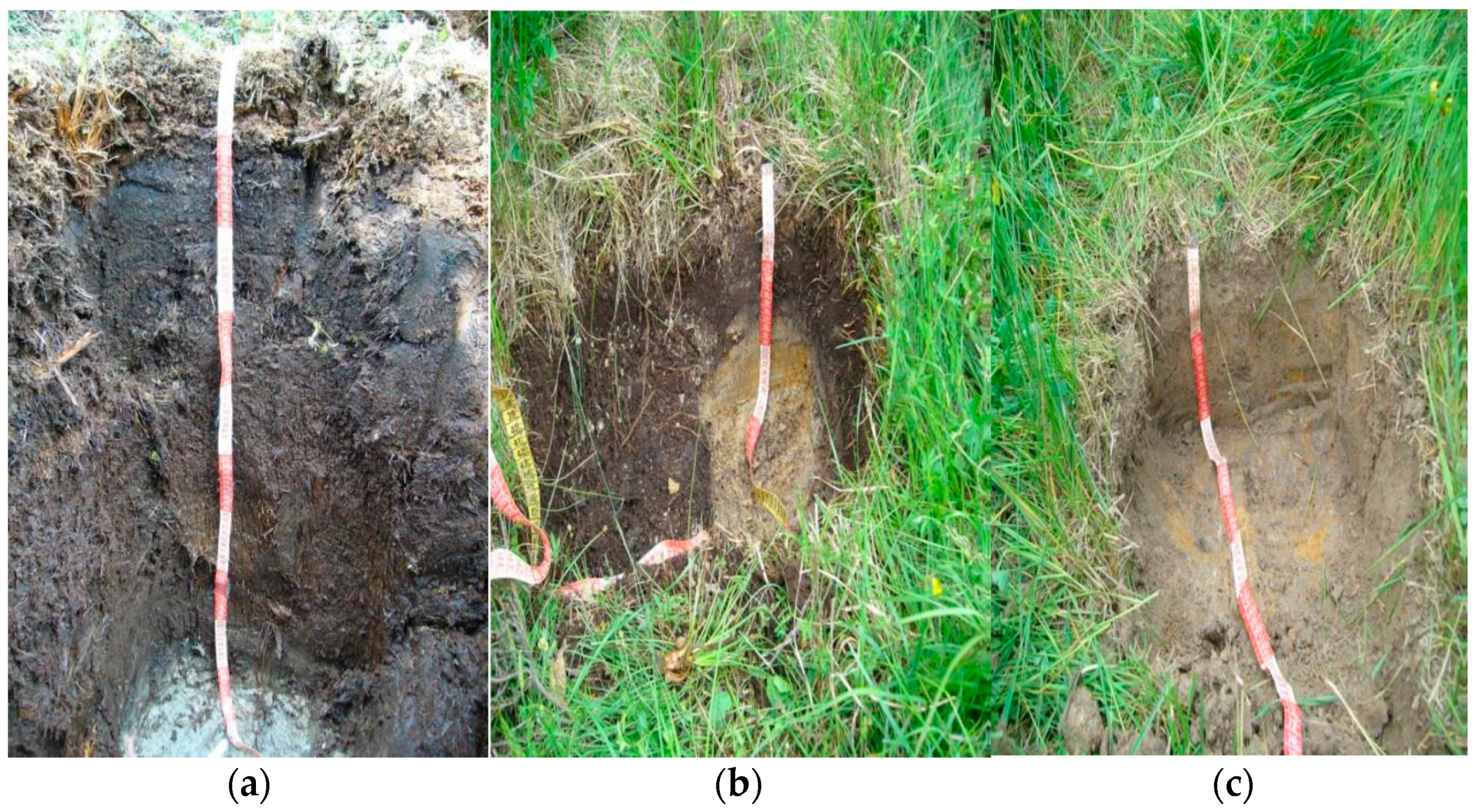
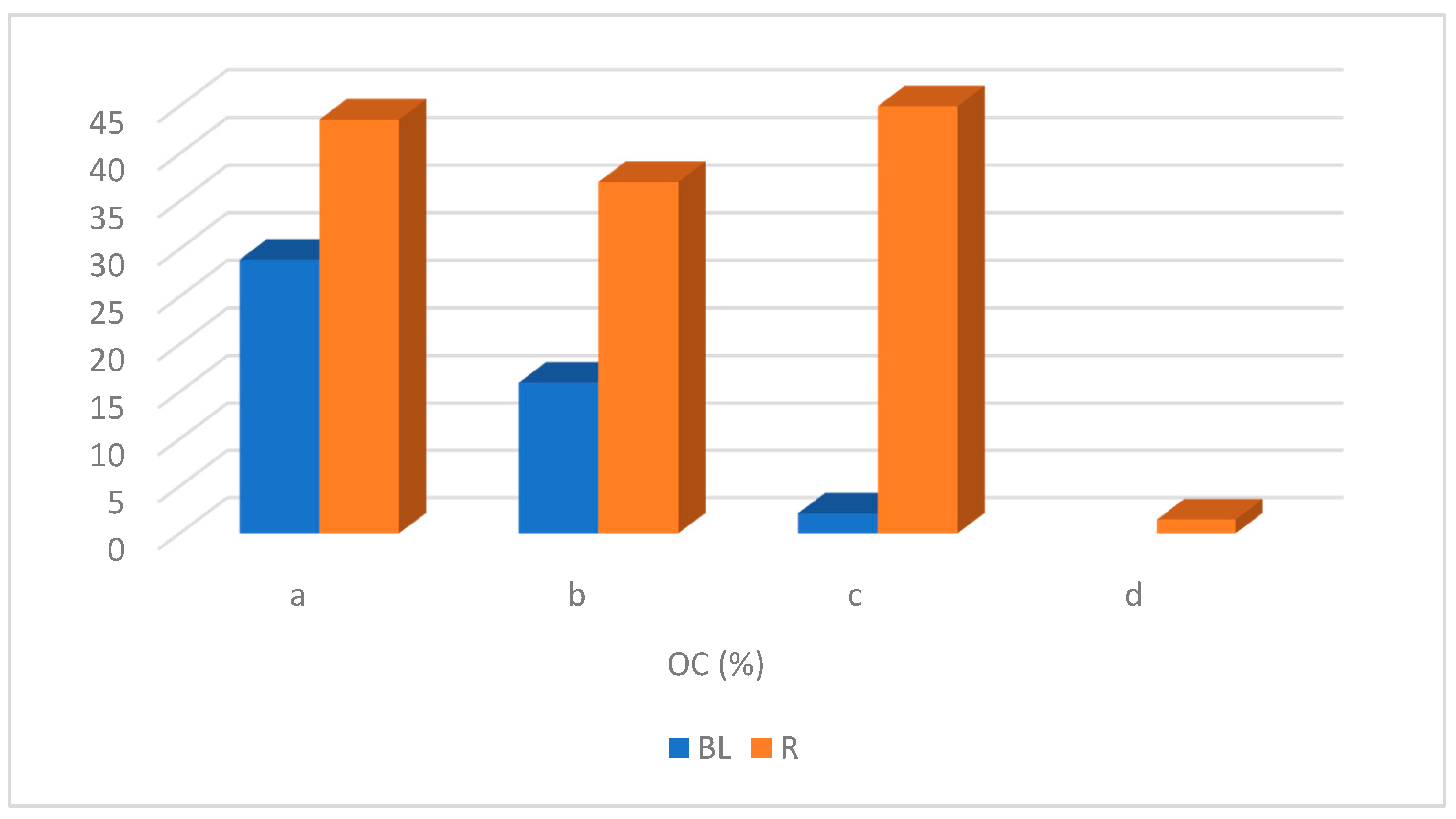
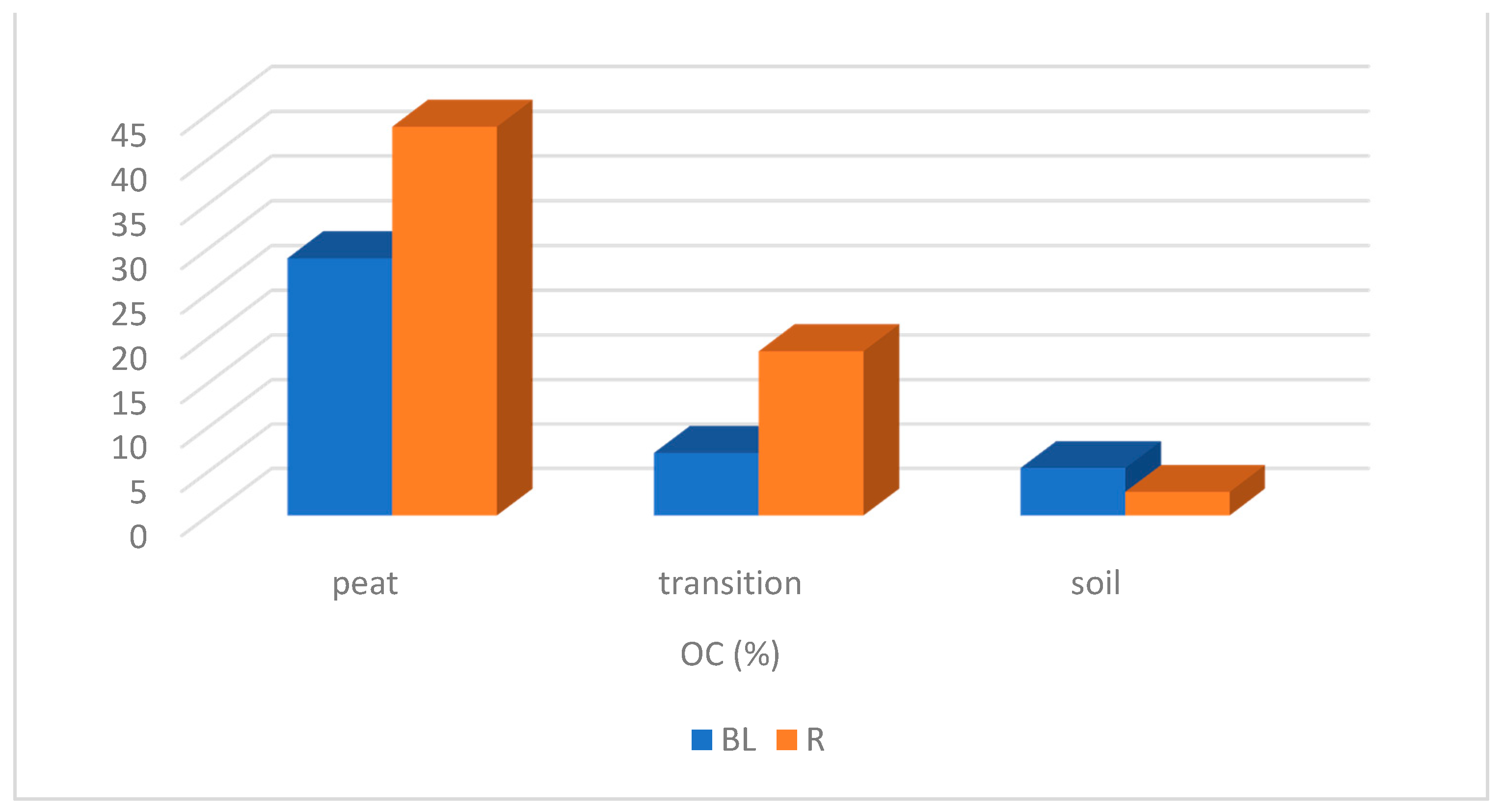



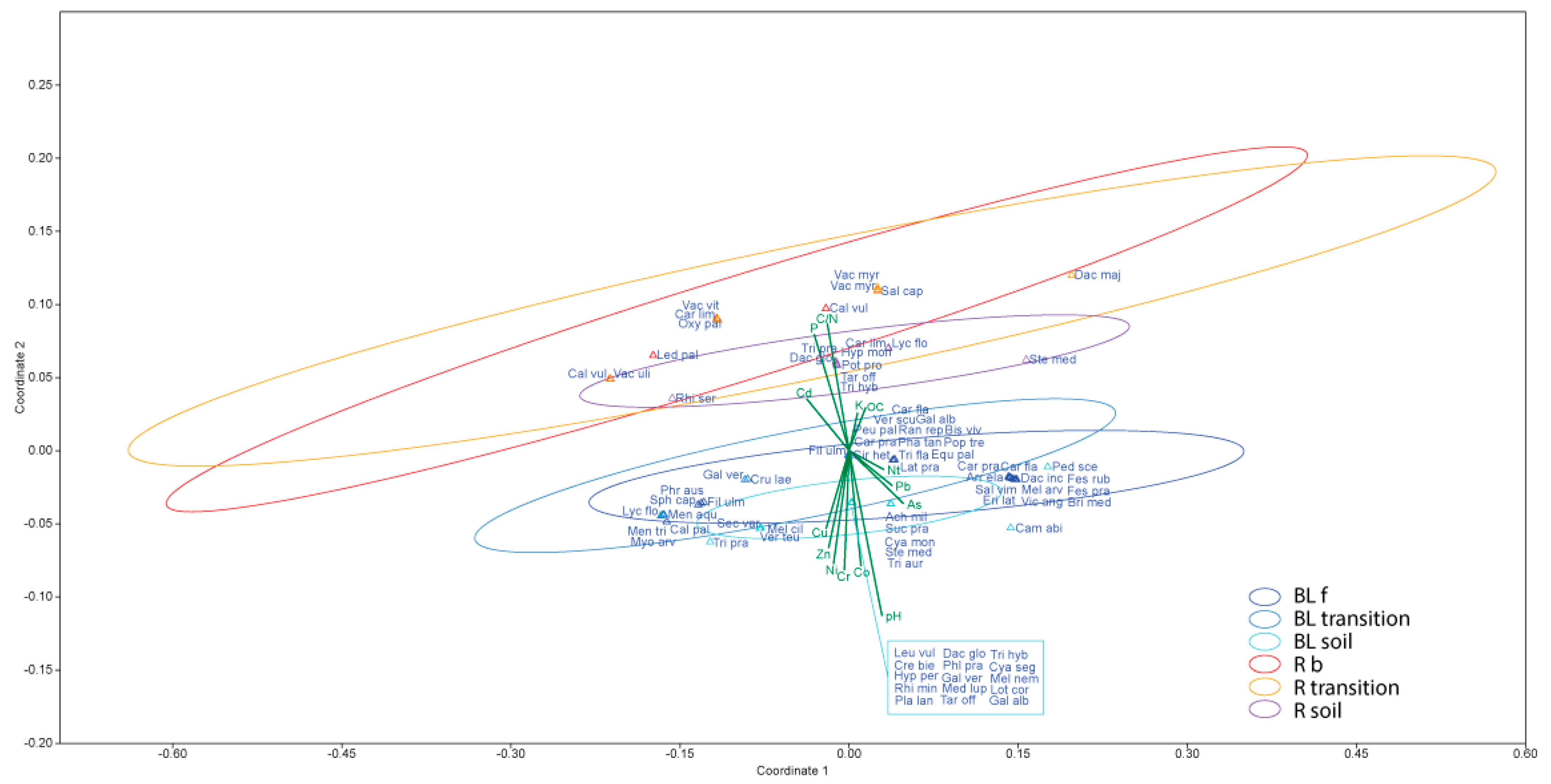
| Peat | 230–184 | 184–157 | 157–143 | 143–106 | 106–87 | 87–43 | 43–15 | Caliph | Car | α |
|---|---|---|---|---|---|---|---|---|---|---|
| ppm | % | |||||||||
| BL f | 2.44 | 11.86 | 6.31 | 27.45 | 11.62 | 28.44 | 11.88 | 51.94 | 33.76 | 39 |
| R b | 0.94 | 8.58 | 5.99 | 22.47 | 11.94 | 34.94 | 15.14 | 62.02 | 28.46 | 31 |
| Localities | Depth (cm) | OC (%) | Nt(mg/kg) | C/N | P (mg/kg) | K (mg/kg) | pH (KCl) |
|---|---|---|---|---|---|---|---|
| BL f | 5–15 | 28.87 | 20,200 | 14.3 | <0.4 | 377 | 7.3 |
| BL f | 20–30 | 15.96 | 9200 | 17.4 | <0.4 | 132 | 7.6 |
| BL f | 110–120 | 2.12 | 1970 | 10.8 | <0.4 | 84.9 | 7.4 |
| BL transition | 10–20 | 7.06 | 7300 | 9.7 | <0.4 | 103 | 7.2 |
| BL soil | 10–20 | 5.36 | 5300 | 10.1 | 1.8 | 104 | 6.6 |
| R b | 0–10 | 43.57 | 14,300 | 30.5 | 94.5 | 636 | 3.0 |
| R b | 15–25 | 37.03 | 14,500 | 25.6 | 59.3 | 291 | 2.9 |
| R b | 35–45 | 44.98 | 12,000 | 37.0 | 17.9 | 61.9 | 2.8 |
| R b | 95–103 | 1.47 | 900 | 16.3 | 14.8 | 43.7 | 3.5 |
| R transition | 5–15 | 18.48 | 8400 | 22.0 | 3.5 | 180 | 3.4 |
| R soil | 3–13 | 2.66 | 2300 | 11.6 | 30.5 | 61.7 | 4.0 |
| Localities | Depth (cm) | As | Cd | Co | Cu | Cr | Ni | Pb | Zn |
|---|---|---|---|---|---|---|---|---|---|
| BL f | 5–15 | 113.0 | <0.2 | 2.3 | 4.4 | 9.5 | 0.0 | 58.6 | 71.0 |
| BL f | 20–30 | 64.9 | 0.4 | 3.5 | 2.3 | 4.1 | 0.1 | 25.1 | 46.6 |
| BL f | 110–120 | 7.3 | <0.2 | 12.2 | 53.3 | 26.9 | 36.4 | 19.0 | 54.3 |
| BL transition | 10–20 | 8.4 | 0.3 | <1.2 | 47.7 | 10.9 | 22.8 | 30.8 | 84.7 |
| BL soil | 10–20 | 13.3 | 0.4 | 6.3 | 54.0 | 17.8 | 35.1 | 29.6 | 94.6 |
| R b | 0–10 | 2.6 | 0.5 | <1.2 | 2.2 | 9.8 | 1.9 | 28.6 | 110.1 |
| R b | 15–25 | 8.0 | 2.4 | <1.2 | 6.7 | 9.4 | 3.1 | 88.6 | 61.5 |
| R b | 35–45 | 3.2 | 0.8 | <1.2 | 2.5 | 2.8 | 0.7 | 52.3 | 37.5 |
| R b | 95–103 | 3.8 | <0.2 | 10.9 | 27.3 | 4.8 | 6.3 | 13.4 | 14.7 |
| R transition | 5–15 | 5.5 | 0.6 | <1.2 | 13.4 | 8.9 | 5.6 | 44.6 | 28.4 |
| R soil | 3–13 | 5.5 | <0.2 | <1.2 | 34.1 | 6.6 | 8.6 | 18.2 | 27.1 |
| Limit value * | 25 | 0.7 | 15 | 60 | 150 | 50 | 70 | 150 |
| Localities | Covering (%) | Number of Species | Species | Code | H’ | e |
|---|---|---|---|---|---|---|
| BL f | 100% | 22 | E0: Sphagnum palustre4 E1: Menyanthes trifoliata5, Phragmites australis4, Filipendula ulmaria4, Dactylorhiza incarnata2, Eriophorum latifolium2, Salix viminalis2, Carex flava2, Carex x prahliana2, Briza media2, Arrhenatherum elatius2, Festuca pratensis2, Festuca rubra2, Vicia angustifolia2, Melampyrum arvense2, Equisetum palustre1, Populus tremula1, Ranunculus reptans1, Trisetum flavescens1, Cirsium heterophyllum1, Phacelia tanacetifolia1, Lathyrus pratensis1 E2, E3: no species were recorded | Sph pal Men tri Phr aus Fil ulm Dac inc Eri lat Sal vim Car fla Car pra Bri med Arr ela Fes pra Fes rub Vic ang Mel arv Equ pal Pop tre Ran rep Tri fla Cir het Pha tan Lat pra | 2.4 | 0.79 |
| BL transition | 100% | 14 | E0: no species were recorded E1:Galium verum3, Cruciata laevipes3, Veronica scutellaria2, Bistorta vivipara2, Galium album2, Carex flacca2, Carex x prahliana2, Peucedanum palustre2, Filipendula ulmaria2, Mentha aquatica1, Myosotis arvensis1, Lychnis flos-cuculi1, Caltha palustris1, Pedicularis sceptrum- carolinumr E2, E3: no species were recorded | Gal ver Cru lae Ver scu Bis viv Gal alb Car flc Car pra Peu pal Fil ulm Men aqu Myo arv Lyc flo Cal pal Ped sce | 2.3 | 0.86 |
| BL soil | 100% | 26 | E0: no species were recorded E1: Trifolium pratense4, Veronica teucrium3, Securigera varia3, Melica ciliata3, Leucanthemum vulgare2, Dactylis glomerata2, Galium verum2, Hypericum perforatum2, Medicago lupulina2, Phleum pratense2, Plantago lanceolata2, Rhinanthus minor2, Taraxacum officinale2, Trifolium hybridum2, Achillea millefolium1, Cyanus montanus1, Trifolium aureum1, Stellaria media1, Cyanus segetum2, Succisa pratensis1, Melampyrum nemorosum2, Lotus corniculatus2, Galium album2, Crepis biennis2, Campanula abietina+ E2, E3: no species were recorded | Tri pra Ver teu Sec var Mel cil Leu vul Dac glo Gal ver Hyp per Med lup Phl pra Pla lan Rhi min Tar off Tri hyb Ach mil Cya mon Tri aur Ste med Cya seg Suc pra Mel nem Lot cor Gal alb Cre bie Cam abi | 2.8 | 0.83 |
| Localities | Covering (%) | Number of species | Species | Code | H’ | e |
|---|---|---|---|---|---|---|
| R b | 90% | 5 | E0: no species were recorded E1: Vaccinium uliginosum5, Ledum palustre4, Vaccinium vitis-idaea3, Calluna vulgaris2, Vaccinium myrtillus1 E2, E3: no species were recorded | Vac uli Led pal Vac vit Cal vul Vac myr | 1.3 | 0.78 |
| R transition | 80% | 6 | E0: no species were recorded E1: Calluna vulgaris5, Oxycoccus palustris3, Carex limosa3, Vaccinium myrtillus1, Salix caprea1, Dactylorhiza majalisr E3: no species were recorded | Cal vul Oxy pal Car lim Vac myr Sal cap Dac maj | 1.2 | 0.67 |
| R soil | 100% | 10 | E0: no species were recorded E1: Rhinanthus serotinus4, Trifolium hybridum2, Taraxacum officinale2, Trifolium pratense2, Dactylis glomerata2, Potentilla x procumbentireptans2, Lychnis flos-cuculi1, Carex limosa1, Hypericum montanum1, Stellaria media+ E2, E3: no species were recorded | Rhi ser Tri hyb Tar off Tri pra Dac glo Pot pro Lyc flo Car lim Hyp mon Ste med | 1.7 | 0.72 |
Publisher’s Note: MDPI stays neutral with regard to jurisdictional claims in published maps and institutional affiliations. |
© 2021 by the authors. Licensee MDPI, Basel, Switzerland. This article is an open access article distributed under the terms and conditions of the Creative Commons Attribution (CC BY) license (https://creativecommons.org/licenses/by/4.0/).
Share and Cite
Fazekašová, D.; Barančíková, G.; Fazekaš, J.; Štofejová, L.; Halas, J.; Litavec, T.; Liptaj, T. Chemical and Phytocoenological Characteristics of Two Different Slovak Peatlands. Plants 2021, 10, 1290. https://doi.org/10.3390/plants10071290
Fazekašová D, Barančíková G, Fazekaš J, Štofejová L, Halas J, Litavec T, Liptaj T. Chemical and Phytocoenological Characteristics of Two Different Slovak Peatlands. Plants. 2021; 10(7):1290. https://doi.org/10.3390/plants10071290
Chicago/Turabian StyleFazekašová, Danica, Gabriela Barančíková, Juraj Fazekaš, Lenka Štofejová, Ján Halas, Tadeáš Litavec, and Tibor Liptaj. 2021. "Chemical and Phytocoenological Characteristics of Two Different Slovak Peatlands" Plants 10, no. 7: 1290. https://doi.org/10.3390/plants10071290
APA StyleFazekašová, D., Barančíková, G., Fazekaš, J., Štofejová, L., Halas, J., Litavec, T., & Liptaj, T. (2021). Chemical and Phytocoenological Characteristics of Two Different Slovak Peatlands. Plants, 10(7), 1290. https://doi.org/10.3390/plants10071290






